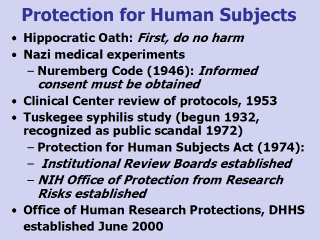 |
The NIH Clinical
Center was established in a postwar world still haunted by the Nazi medical
experiments. When it opened, it was governed not only by an internal review
of protocols but also by the provisions of the 1946 Nuremberg Code mandating
that informed consent be obtained from human research subjects and by the
ancient Hippocratic Oath to do no harm. In 1972, public reports of the
Tuskegee syphilis study revealed that African American males in a study of
the natural history of syphilis infection had not been given antibiotics
even after they became available. This scandal led Congress to enact the
1974 Protection for Human Subjects Act which mandated Institutional Review
Boards for research projects that utilized human subjects. It also created
the NIH Office of Protection from Research Risks, an office which in June
2000 was renamed the Office of Human Research Protections and transferred to
the Office of the Secretary, Department of Health and Human Services. |
